SIU Director’s Report - Case # 22-OFD-233
Warning:
This page contains graphic content that can shock, offend and upset.
Contents:
Mandate of the SIU
The Special Investigations Unit is a civilian law enforcement agency that investigates incidents involving an official where there has been death, serious injury, the discharge of a firearm at a person or an allegation of sexual assault. Under the Special Investigations Unit Act, 2019 (SIU Act), officials are defined as police officers, special constables of the Niagara Parks Commission and peace officers under the Legislative Assembly Act. The SIU’s jurisdiction covers more than 50 municipal, regional and provincial police services across Ontario.
Under the SIU Act, the Director of the SIU must determine based on the evidence gathered in an investigation whether there are reasonable grounds to believe that a criminal offence was committed. If such grounds exist, the Director has the authority to lay a criminal charge against the official. Alternatively, in cases where no reasonable grounds exist, the Director cannot lay charges. Where no charges are laid, a report of the investigation is prepared and released publicly, except in the case of reports dealing with allegations of sexual assault, in which case the SIU Director may consult with the affected person and exercise a discretion to not publicly release the report having regard to the affected person’s privacy interests.
Information Restrictions
Special Investigations Unit Act, 2019
Pursuant to section 34, certain information may not be included in this report. This information may include, but is not limited to, the following:- The name of, and any information identifying, a subject official, witness official, civilian witness or affected person.
- Information that may result in the identity of a person who reported that they were sexually assaulted being revealed in connection with the sexual assault.
- Information that, in the opinion of the SIU Director, could lead to a risk of serious harm to a person.
- Information that discloses investigative techniques or procedures.
- Information, the release of which is prohibited or restricted by law.
- Information in which a person’s privacy interest in not having the information published clearly outweighs the public interest in having the information published.
Freedom of Information and Protection of Privacy Act
Pursuant to section 14 (i.e., law enforcement), certain information may not be included in this report. This information may include, but is not limited to, the following:- Confidential investigative techniques and procedures used by law enforcement agencies; and
- Information that could reasonably be expected to interfere with a law enforcement matter or an investigation undertaken with a view to a law enforcement proceeding.
- The names of persons, including civilian witnesses, and subject and witness officials;
- Location information;
- Witness statements and evidence gathered in the course of the investigation provided to the SIU in confidence; and
- Other identifiers which are likely to reveal personal information about individuals involved in the investigation.
Personal Health Information Protection Act, 2004
Pursuant to this legislation, any information related to the personal health of identifiable individuals is not included.Other proceedings, processes, and investigations
Information may also have been excluded from this report because its release could undermine the integrity of other proceedings involving the same incident, such as criminal proceedings, coroner’s inquests, other public proceedings and/or other law enforcement investigations.Mandate Engaged
Pursuant to section 15 of the SIU Act, the SIU may investigate the conduct of officials, be they police officers, special constables of the Niagara Parks Commission or peace officers under the Legislative Assembly Act, that may have resulted in death, serious injury, sexual assault or the discharge of a firearm at a person.
A person sustains a “serious injury” for purposes of the SIU’s jurisdiction if they: sustain an injury as a result of which they are admitted to hospital; suffer a fracture to the skull, or to a limb, rib or vertebra; suffer burns to a significant proportion of their body; lose any portion of their body; or, as a result of an injury, experience a loss of vision or hearing.
In addition, a “serious injury” means any other injury sustained by a person that is likely to interfere with the person’s health or comfort and is not transient or trifling in nature.
This report relates to the SIU’s investigation into the death of a 40-year-old man (the “Complainant”).
The Investigation
Notification of the SIU
On September 12, 2022, at about 5:05 p.m., the Hamilton Police Service (HPS) contacted the SIU with the following information.On September 12, 2022, Toronto Police Service (TPS) officers were doing a training exercise in Mississauga. A person [now known to be the Complainant] shot one of the TPS officers and fled to Milton, where he shot another person. The Complainant’s cellular telephone was ‘pinged’[1] and he was eventually located in the cemetery at 777 York Boulevard, Hamilton. HPS and Halton Regional Police Service (HRPS) officers engaged the Complainant, and he was shot dead.
The Team
Date and time team dispatched: 09/12/2022 at 5:58 p.m.Date and time SIU arrived on scene: 09/12/2022 at 6:26 p.m.
Number of SIU Investigators assigned: 5
Number of SIU Forensic Investigators assigned: 5
Affected Person (aka “Complainant”):
40-year-old male; deceasedCivilian Witnesses (CW)
CW #1 Not interviewed; next-of-kinCW #2 Interviewed
CW #3 Interviewed
The civilian witnesses were interviewed on September 13, 2022.
Subject Officials (SO)
SO #1 Interviewed; notes received and reviewedSO #2 Interviewed; notes received and reviewed
SO #3 Interviewed, but declined to submit notes, as is the subject official’s legal right
SO #4 Declined interview and to provide notes, as is the subject official’s legal right
The subject officials were interviewed between September 28, 2022, and October 13, 2022.
Witness Officials (WO)
WO #1 InterviewedWO #2 Interviewed
WO #3 Interviewed
WO #4 Interviewed
WO #5 Interviewed
WO #6 Interviewed
WO #7 Interviewed
WO #8 Interviewed
WO #9 Interviewed
WO #10 Interviewed
WO #11 Interviewed
WO #12 Interviewed
WO #13 Not interviewed; notes received and reviewed
WO #14 Not interviewed; notes received and reviewed
WO #15 Not interviewed; notes received and reviewed
WO #16 Not interviewed; notes received and reviewed
WO #17 Not interviewed; notes received and reviewed
WO #18 Interviewed
The witness officials were interviewed between September 15 and 29, 2022.
Evidence
The Scene
The scene was located at 777 York Boulevard, Hamilton, in the lower bowl of the Hamilton Cemetery. 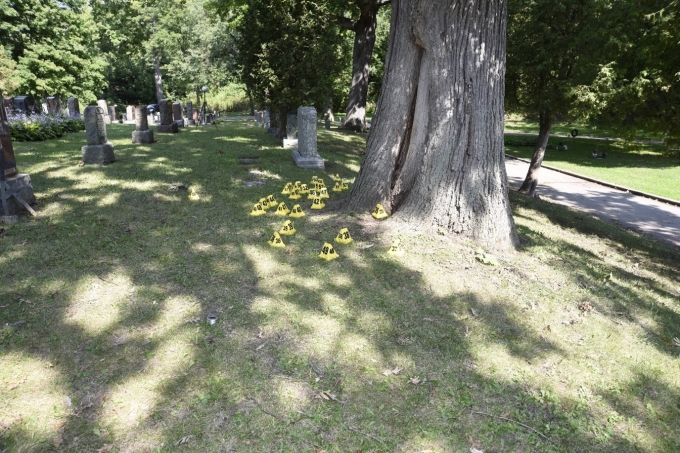
Figure 1 – The scene depicting evidence by a tree
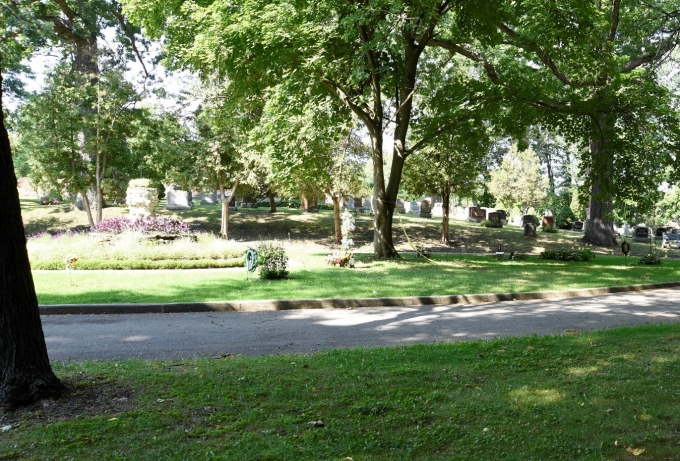
Figure 2 - Lower cemetery area of the scene
Scene Diagram
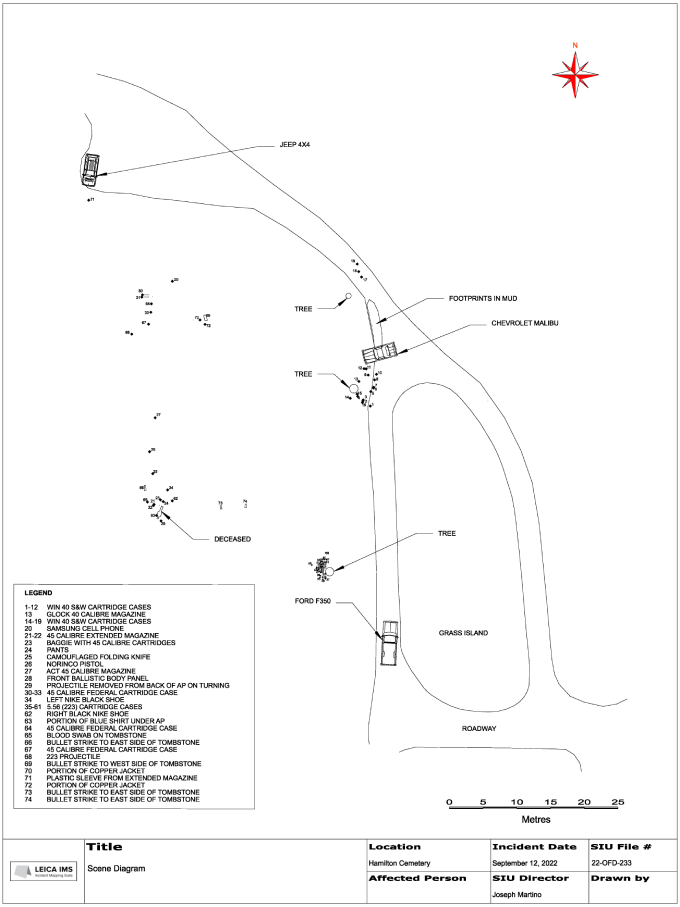
Physical Evidence
The large cemetery was located on the west side of York Boulevard. SIU forensic investigators travelled down a steep road to the extreme west side of the cemetery. This area was secluded from the main cemetery area and below the grade of the main cemetery. The road at the bottom of the steep decline was a rough figure-eight. The gravestones were in an area approximately 120 metres long, by 35 metres wide, and ran in a north-south direction. The gravestones were surrounded by railway tracks on the west, the figure-eight roadway on the east, a gravel road on the north and a wooden area to the south. Numerous mature trees scattered the area
There were no streetlights or extraneous lights, and the area would soon be in complete darkness, so it was decided that the scene should be photographed, searched for evidence, and evidence marked and collected, and that the scene should be held overnight for a more thorough search with additional personnel the next day.
There were three vehicles within the protected area of the lower cemetery:
- A Ford F350 pickup truck. This vehicle had a hard storage cap over the rear bed and was later determined to be a HRPS tactical truck, but it was not marked with any police markings. It was parked on the roadway east of the headstones.
- A Chevrolet Malibu. It was parked on the north end of the figure-eight roadway facing west towards the headstones. The front doors were fully opened. This vehicle was later determined to be a HPS vehicle, but it did not have any police markings.
- A Jeep Cherokee. It was parked at the end of a gravel sideroad which branched off the north end of the figure-eight roadway. It was along the most northwest portion of the lower cemetery. The vehicle was facing south towards the headstones. The front side windows were in the down position, and the rear hatch was open. The keys were in the ignition in the accessory position, and the radio was on. This vehicle was photographed to show its position and the interior. There was a reflective construction-type vest on the passenger side next to the centre console. The vehicle was subsequently found to have two possible bullet defects.
Near the Complainant’s feet were two loaded large-capacity magazines for a pistol and a plastic bag with additional ammunition. The large-capacity magazines were later examined and each held ten, .45 calibre bullets.
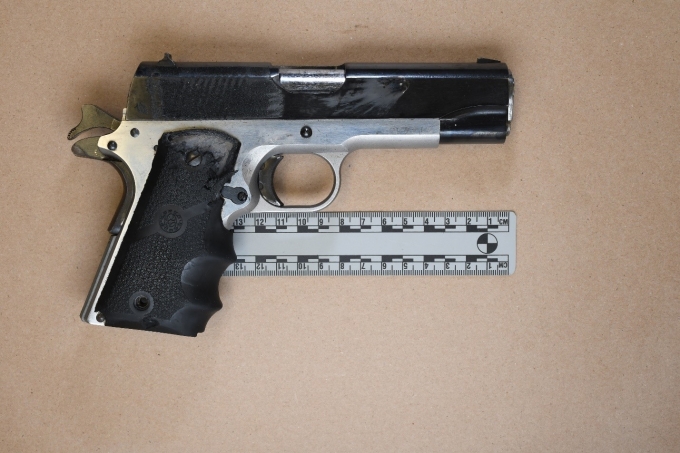
Figure 3 – The Complainant’s Norinco pistol
A trail of blood drops on the ground, north of the body was observed.
The area between the Jeep Cherokee and south towards the body was approximately 50 metres. This area was searched for evidence and the following items were located that night:
- Approximately 20 metres south of the Jeep, four .45 calibre cartridge cases and a cell phone were located.
- Approximately 15 metres south of the cartridge cases was a magazine for a pistol. It was empty of bullets, but it could hold a maximum of seven cartridges.
- A few metres south of the magazine was a Norinco .45 calibre pistol. It was unloaded and the magazine was missing. The hammer was pulled back to the cocked position.
- Also, along this path from the Jeep to the body was a camouflage-coloured folding knife in the closed position.
On the right side of the HPS Chevrolet Malibu were three more S&W WIN .40 calibre cartridge cases. These cartridge cases were about 11 metres from the car. Shoe prints in the mud led from the right side of the vehicle towards these cartridge cases. The shoe prints were small with a small separate heel, possibly indicating a female-style shoe.
A search around the Ford F350 pickup truck revealed 27 cartridge cases with the headstamp ‘Hornady 5.56 NATO’. These cartridge cases were near a tree, approximately 14 metres northwest of the driver’s door.
At 9:20 p.m., the Coroner attended and examined the body. Three more apparent bullet injuries were noted to the chest. The Complainant’s back could not be examined at the scene because his hoody and the back panel of the ballistic vest were still in position covering the skin. There was a fired bullet stuck to the back of his shirt which was removed and collected as an exhibit.
The body was removed and transported to the Ontario Forensic Pathology Unit in Toronto for post-mortem examination, scheduled for September 14, 2022.
All evidence was photographed showing its location prior to collection, and overall photographs were also taken.
On September 13, 2022, at 1:50 a.m., SIU forensic investigators left the scene with instructions for HPS to secure the scene overnight.
At 8:00 a.m., SIU forensic investigators returned to the scene.
The scene was measured with a surveying device to produce a scale scene drawing.
There were four headstones that displayed evidence of bullet strikes. The bullet strikes were on both sides of the headstones indicating that shots were fired from the position of the officers and the position of the deceased. This conclusion was based on the location of the police cartridge cases and the .45 calibre cartridge cases.
Two additional .45 calibre cartridge cases were located in the grass. [2] Bullet fragments were also located and collected during a metal detector search.
In summary, the following exhibits were collected from the scene:
- 27 – 5.56 calibre cartridge cases typically fired from police C-8 rifles were in a cluster, approximately 12.5 metres northwest of the front of the HRPS tactical vehicle.
- 18 - .40 calibre cartridge cases typically fired from police pistols were found near the HPS unmarked Chevrolet Malibu. Fifteen of these cartridge cases were on the left side of the car and an empty Glock magazine was among them. Three of these cartridge cases were on the right side of the car.
- Several fragments from fired bullets were located during the search of the scene. Their locations were documented in the scale scene diagram.
- A plastic sleeve that slides over a magazine was found in front of the Jeep.
- Approximately 20 metres south of the Jeep, six .45 calibre cartridge cases were found as well as a cell phone.
- Following a line directly south from the .45 calibre cartridge cases several other items were located. Sixteen metres south of these cartridge cases there was an empty .45 calibre magazine with a 7-round capacity. Five metres south of the magazine was the Norinco .45 calibre pistol. The magazine was missing from the pistol, the hammer was in the cocked position, and the breech was empty.
- A camouflage-coloured folding knife was a short distance south of the pistol.
- Located around the body were two large capacity magazines for a .45 calibre pistol. They were later found to have a capacity of ten bullets, and they were fully loaded.
- A clear plastic bag contained none more .45 calibre bullets.
- Several items of clothing, shoes, and the front panel of the ballistic vest were found around the body.
All items were collected and later transported to the SIU office where they were secured in a Case Room.
On September 14, 2022, SIU forensic investigators attended at the HPS Central Station to document the use of force equipment belonging to the HPS subject officials. A HPS staff sergeant directed the SIU forensic investigators to a room where the equipment had been locked into lockers. The staff sergeant opened lockers #40 and #41.
Locker #40 contained the equipment of SO #2 and consisted of a police ballistic vest and firearm. The vest was a black vest with ‘POLICE’ in large reflective letters across the back and front. SO #2’s last name and badge number were embroidered on the upper right chest. There were several pockets across the front. Inside the pockets were a police radio and microphone, Narcan, tourniquet, handcuffs, safety glasses, and keys.
There was a police firearm in a plastic evidence bag. Writings on the bag indicated that the firearm was obtained from SO #2 at 7:27 p.m. by a named HPS sergeant. The bag was opened, and the firearm was examined. It was a Glock 22 .40 calibre pistol in a detective’s holster. It was loaded with a live bullet in the breech and a magazine of bullets. Thirteen live bullets were in the magazine. [3] All the bullets had the headstamp ‘WIN 40 S&W’.
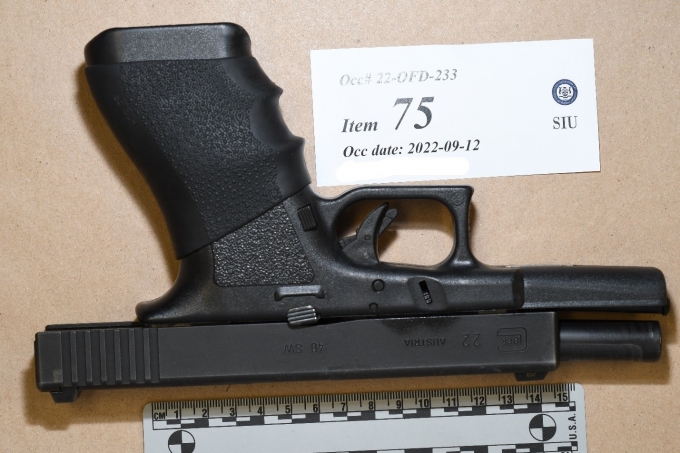
Figure 4 – SO #2’s firearm
Locker #41 contained the equipment of SO #1 and consisted of a police ballistic vest and firearm. The vest was a black vest with ‘POLICE’ in large reflective letters across the back and front. SO #1’s last name and badge number were embroidered on the upper right chest. There were several pockets across the front. Inside the pockets were a police radio and microphone, handcuffs, tourniquet, and Narcan.
There was a police firearm in a plastic evidence bag. Writings on the bag indicated that the firearm was obtained from SO #1 at 7:35 p.m. by a named HPS officer. The bag was opened, and the firearm was examined. It was a Glock 22 .40 calibre pistol in a detective’s holster. It was loaded with a live bullet in the breech and a magazine of bullets. Eleven live bullets were in the magazine. All the bullets had the headstamp ‘WIN 40 S&W’.
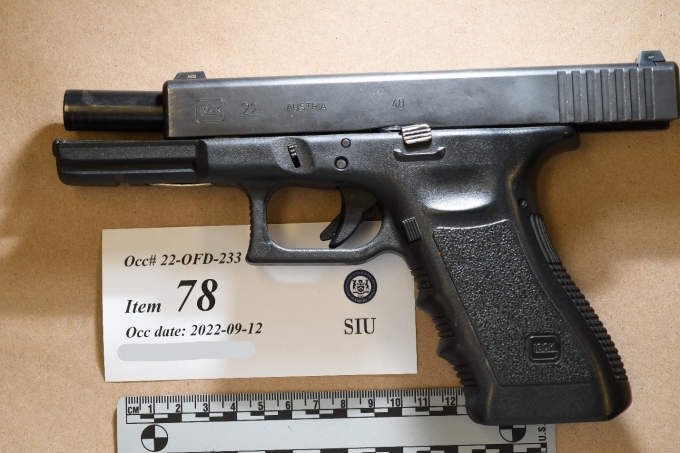
Figure 5 – SO #1’s firearm
Both pistols and the ammunition were collected by the SIU. The remainder of the police equipment was photographed and returned to the HPS.
At 9:20 a.m., the SIU forensic investigators attended the HRPS Headquarters where they were directed to a forensic examination room in which the equipment of the subject officials had been stored.
The items belonging to SO #4 consisted of:
- A grey tactical uniform, black boots, and black baseball-style hat.
- A black police ballistic vest with the following equipment attached or in various pockets: medical kit, conducted energy weapon (CEW) holster, flashlight, mini flashbang, police radio with earpiece, tourniquet, safety glasses and a magazine for a C-8 rifle with 28 live 5.56 bullets.
- A duty belt with the following items: Gerber multitool, pistol holster, tourniquet, black gloves, handcuffs, folding knife, and two 9 mm magazines with 15 live 9 mm bullets in each.
- A Sig Sauer Model P226 9 mm pistol, with a magazine containing 15 live 9 mm bullets and another 9 mm bullet from the breech.
- A Colt C-8 Carbine 5.56 rifle equipped with a sling and optical sight.
- A magazine for the Colt C-8 with 16 live 5.56 cartridges
- A CEW with two live cartridges.
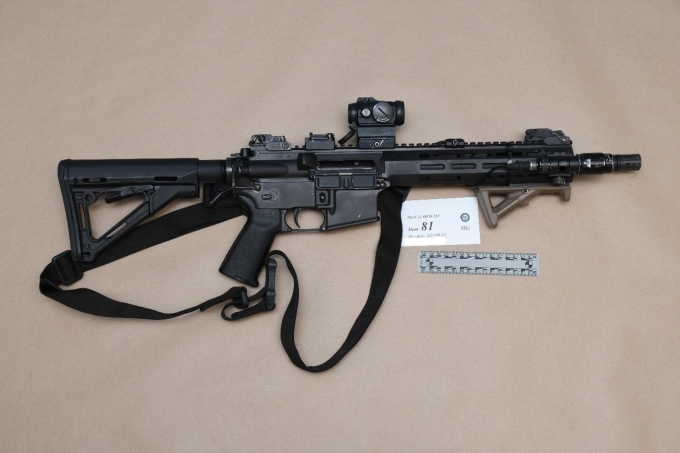
Figure 6 – SO #4’s C-8 rifle
The items belonging to SO #3 consisted of:
- A grey tactical uniform with smears of blood, black boots, and black baseball-style hat.
- A black police tactical vest with the following equipment attached or in various pockets: black gloves, black marker, CEW holster with a Taser X2 loaded with two live cartridges, mini flashbang, two 9 mm magazines with 15 live 9 mm bullets in each, tourniquet, two magazines for a C-8 rifle each containing 28 live 5.56 bullets, a pry tool, radio and earpiece, mini flashlight and zip tie flex cuffs.
- Leg pistol holster with flashlight.
- A Sig Sauer Model P226 9 mm pistol, with a magazine containing 15 live 9 mm bullets and another 9 mm bullet from the breech.
- A Colt C-8 Carbine 5.56 rifle equipped with a sling and optical sight.
- A magazine for the Colt C-8 with 12 live 5.56 cartridges.
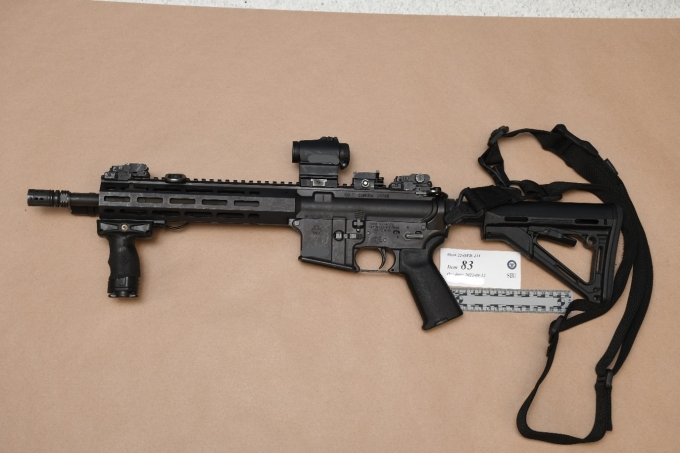
Figure 7 – SO #3’s C-8 rifle
The two C-8 rifles and their ammunition were collected by the SIU, but not the ammunition or magazines. These items were taken to SIU and secured in a weapons vault.
Forensic Evidence
Centre of Forensic Sciences (CFS) Submissions
Testing by the CFS of exhibits collected by the SIU yielded the following results.Of the 18 .40 calibre cartridge cases found at the cemetery:
- 15 were identified as coming from HPS SO #2’s Glock pistol.
- Three were identified as coming from HPS SO #1’s Glock pistol.
- All seven were fired from the Norinco 1911A1C pistol found near the body of the Complainant.
- 16 shared limited agreement of individual characteristics to test-fired cartridge cases generated from HRPS SO #3’s rifle. The limited agreement of individual characteristics prevented positive identification; however, they were sufficient to eliminate them as having been fired from the rifle possessed by HRPS SO #4.
- Five shared limited agreement of individual characteristics to test-fired cartridge cases generated from SO #4’s rifle. The limited agreement of individual characteristics prevented positive identification; however, they were sufficient to eliminate them as having been fired from the rifle possessed by HRPS SO #3.
- Six could neither be identified or eliminated as having been fired by either SO #3’s or SO #4’s rifle.
- One bullet was found attached to the clothing covering the Complainant’s back when the Coroner rolled him over. There was no defect in the clothing at this location - the bullet was simply clinging to the material. The bullet did not bear sufficient individual characteristics for identification, but it did share class characteristics with the Glock pistols belonging to the HPS officers.
- One bullet was found among the headstones close to the cluster of .45 calibre cartridge cases. It shared limited agreement of individual characteristics to test-fired bullets generated from HRSP SO #4’s rifle. The limited agreement of individual characteristics prevented positive identification; however, they were sufficient to eliminate the bullet as having been fired from the rifle possessed by HRPS SO #3.
- One bullet fragment was found next to a headstone with a bullet strike. The bullet strike was on the west side of the headstone indicating it came from the Complainant’s position and was directed to the HPS subject officials. This bullet was identified as having been fired from the Complainant’s Norinco pistol.
- The last remaining fragment from the cemetery was of no identification value.
- One bullet was recovered from the body bag. It was a .22 rifle calibre class bullet (5.56 mm). It shared limited agreement of individual characteristics to test-fired bullets generated from HRSP SO #4’s rifle. The limited agreement of individual characteristics prevented positive identification. however, they were sufficient to eliminate the bullet as having been fired by HRPS SO #3’s rifle.
- One bullet was recovered from the right chest wall. It was a .22 rifle calibre class bullet (5.56 mm). It shared limited agreement of individual characteristics to test-fired bullets from SO #4’s rifle; however, it could neither be identified nor eliminated as having been fired by the HRPS rifles.
- One bullet was recovered from the posterior chest wall. It was a bullet core of indeterminate calibre and did not have identification value.
- Metal fragments from the left shoulder did not have identification value.
- One bullet and fragment from the right hip. It was a .22 rifle calibre class bullet (5.56 mm). There was limited agreement of individual characteristics to test-fired bullets from SO #4s rifle; however, it could neither be identified nor eliminated as having been fired by the HRPS rifles.
- One bullet from the right middle lobe. It was a .22 rifle calibre class bullet (5.56 mm). There was limited agreement of individual characteristics to test-fired bullets from HRPS SO #4’s rifle; however, it could neither be identified nor eliminated as having been fired by the HRPS rifles.
- Metal fragment from the left pleural space did not have identification value.
- Metal fragment from the right chest did not have identification value.
- Metal fragment recovered from a panel of the ballistic vest did not have identification value.
Other Scenes
Testing performed by the CFS also linked the Complainant’s Norinco pistol to the shooting of five other people on the same day. Video/Audio/Photographic Evidence [4]
HRPS Tactical Rescue Unit (TRU) Video
On October 4, 2022, at 11:34 a.m., the HRPS advised the SIU that they had in-car camera system (ICCS) footage from the HRPS tactical truck involved in the incident at the cemetery. The footage was received by the SIU on October 4, 2022.A review of the footage indicated that the first two feeds were of SO #3 and SO #4 on a roadway waiting for Communications to update them on a possible triangulation of the Complainant’s cellular telephone.
The other four feeds were blank, reportedly the result of an issue with the feed line to the cameras.
HPS Communications Recordings / Computer-assisted Dispatch (CAD)
HPS provided the pertinent communications recordings and CAD to the SIU on September 14, 2022. HPS and HRPS were not on a common talk channel, so they had to make telephone calls to each other to obtain details to relay to police officers in the field. The following is a summary of the information from these records.At 3:30 p.m., and 3:47 p.m., HPS dispatch called HRPS dispatch to obtain a description of the Complainant and the Jeep. Those calls related to direction of travel for the Jeep.
At 4:14 p.m., HRPS advised HPS that they had identified the Complainant by name and had his cellular telephone, which they had begun to ping. The ping put the Complainant and the Jeep near York Boulevard and Dundurn Street in Hamilton.
At 4:23 p.m., the cellular telephone was pinged to the area of the Hamilton Cemetery at 777 York Boulevard, within a 15-metre radius.
SO #1 advised she and SO #2 were entering the cemetery and, at 4:26 p.m., she announced shots had been fired in the lower part of the cemetery. Gunshots could be heard in the background of the broadcast. SO #1 subsequently indicated that tactical officers were on scene. A request was made for an ambulance and it was noted that the Complainant was down. HPS Communications reported that an ambulance had been requested. WO #2 reported that he had started cardiopulmonary resuscitation.
At 4:32 p.m., Emergency Medical Services (EMS) arrived. There followed multiple broadcasts that too many police vehicles were blocking the path, so EMS had to walk in to attend to the Complainant.
The Complainant was pronounced deceased by EMS at 4:53 p.m.
HRPS Communications Recordings / CAD
HRPS provided pertinent communications recordings to the SIU on September 20, 2022. The initial HRPS communications dealt with direction of travel of the involved Jeep, and sightings of the Jeep that the Complainant had stolen and was driving. The following is a summary of the information from these records.At 3:15 p.m., HRPS Communications notified HPS, Orillia Ontario Provincial Police (OPP), Niagara Regional Police Service, London OPP, and Brantford Police Service of the location of the Jeep and possible direction of travel.
At 3:51 p.m., calls were received about a possible shooting in Halton Region, which dispatch confirmed at 3:57 p.m.
HRPS Communications reported they had a cellular telephone, which they were pinging.
At 4:18 p.m., SO #4 and SO #3 advised that they were in the area where the Jeep had been pinged.
At 4:24 p.m., the officers indicated they were checking the lower area of the cemetery and, a minute later, “Shots fired,” could be heard.
At 4:27 p.m., SO #4 and SO #3 advised that the suspect was down with gunshot wounds. He was handcuffed and still breathing. An ambulance was requested.
The rest of the transmissions dealt with the ambulance and scene security deployment.
Timeline
Mississauga
In the afternoon of September 12, 2022, TPS Officer #1 entered the Tim Hortons located at 3110 Argentia Road. Officer #1 was in a TPS uniform. The Complainant had been waiting in his personal vehicle outside the Tim Hortons since 11:58 a.m. The Complainant had seen Officer #1 park his unmarked police vehicle, and he entered the Tim Hortons ahead of Officer #1. The Complainant paced back and forth for a period of time, looking at the parking lot. At 2:11 p.m., Officer #1 entered the Tim Hortons. Both men made eye contact and nodded at each other.
Officer #1 proceeded towards the counter as the Complainant pushed the handicap button to open the entrance doors. The Complainant took out his handgun and shot Officer #1 in the head, after which he tried to disarm him of his service weapon unsuccessfully. He then shot Officer #1 again in the head and fled the Tim Hortons.
The Complainant proceeded to the Walmart at 3155 Argentia Road, Mississauga, past his own vehicle, and pulled a man out of his Jeep Cherokee. The Complainant shot the man in the stomach, leaving Mississauga in the Jeep.
Milton
At about 2:27 p.m., the Complainant drove the stolen Jeep to an auto repair shop in Milton. The owner had gone to get lunch. He returned from lunch and went to the lunchroom, where he was confronted by the Complainant. The Complainant produced a pistol and shot the owner multiple times.Two employees in the shop saw the shooting and fled. The Complainant discharged his pistol at them, but neither employee was hit.
Inside the business, a second man was seated at the front desk. He recognized the Complainant from the short time the Complainant had worked at the auto repair shop. The Complainant shot him in the leg.
A third man was near the front desk and the Complainant shot him in the head. The Complainant pointed his pistol at the second man again, who leaned forward believing he was going to die. The Complainant fired but instead of a gunshot, a clicking noise was heard. [5]
HRPS arrived on scene at 2:55 p.m., and learned that an ex-employee, the Complainant, was responsible for the shootings. HRPS officers were able to determine his cellular telephone number. They also had two employees of the auto repair shop positively identify the Complainant.
Exigent circumstances allowed HRPS officers to ping the cellular telephone, and information came in that the Complainant’s cellular telephone was in the Hamilton area. The location was later learned to be within a radius that included the Hamilton Cemetery.
Hamilton Cemetery
The Hamilton cemetery was where the Complainant was located by police.Materials Obtained from Police Service
Upon request, the SIU received the following materials from the HRPS and the HPS:- HRPS Call History Remarks;
- HPS Event History;
- HRPS Equipment List;
- HRPS Notes-WO #13;
- HRPS Notes-WO #14;
- HRPS Notes-WO #10;
- HRPS Notes-WO #8;
- HRPS Notes-WO #9;
- HRPS Notes-WO #12;
- HRPS Notes-WO #16;
- HRPS Notes-WO #17;
- HRPS Notes-WO #11;
- HRPS Notes-WO #15;
- HRPS – civilian witness interview;
- HRPS – backgrounder and timelines regarding shootings in Milton;
- HPS Notes-WO #18;
- HPS Policy-Use of Force;
- HPS Notes-WO #7;
- HPS-CAD Report;
- HPS-General Occurrence;
- HPS Notes-WO #4;
- HPS Notes-WO #1;
- HPS Notes-WO #6;
- HPS Notes-WO #3;
- HPS Notes-WO #2;
- HPS Notes-WO #5;
- HPS Notes-SO #2;
- HPS Notes-SO #1;
- HRPS Event Chronology;
- HRPS CAD - Remarks;
- HRPS TRU ICCS vehicle video;
- Scene drawings by SO #2, SO #1, SO #3, WO #8 and WO #9;
- 911 and police communications recordings;
- Booking Data Sheet and Images – the Complainant; and
- HRPS Supplementary Report.
Materials Obtained from Other Sources
The SIU obtained and reviewed the following records from other sources: - Overview and timeline provided by Peel Regional Police (PRP); and
- Various reports from CFS.
Incident Narrative
In the afternoon of September 12, 2022, the Complainant embarked on a murder spree that would see him kill three persons, including a TPS officer, and attempt to kill at least eight other people. Armed with a Norinco .45 calibre pistol and a generous supply of ammunition, the Complainant staked-out the Tim Hortons at 3110 Argentia Road, Mississauga, waiting for a police officer to arrive at the premises. TPS Officer #1, in the area on a training exercise, arrived in full uniform at the restaurant at about 2:11 p.m. The Complainant entered the restaurant after Officer #1 and proceeded to shoot the officer in the head. The Complainant tried and failed to retrieve Officer #1’s firearm from its holster, and then shot the officer again before fleeing the restaurant. Officer #1 died of his wounds.
The Complainant travelled a short distance to 3155 Argentia Road, by-passing his own vehicle, and carjacked a Jeep Cherokee. He pulled the driver out of the vehicle and shot him in the abdomen. The driver would survive his wounds.
The Complainant used to work at an auto repair shop in Milton and believed himself aggrieved by his former employer. He arrived at the shop at about 2:30 p.m., confronted the owner in the garage, and shot him multiple times. The owner died of his wounds. Two employees witnessed the shooting and fled the area. The Complainant fired at them but missed. Two other employees of the shop were confronted in the front desk area by the Complainant. The first employee was shot in the head and would later die of his wounds. The second employee was shot in the leg and lived. The Complainant attempted to shoot the second employee again, but his gun was out of bullets. He fled the scene in the Jeep Cherokee, heading for Hamilton.
HRPS officers were on scene of the auto repair shop quickly after the shooting. The Complainant’s identity was confirmed by employees of the business, as was his mobile phone number. The latter would later be used to ascertain the Complainant’s location.
Police services were put on alert regarding the events in Mississauga and Milton. A description was broadcast of the suspect – the Complainant – and the vehicle he was operating.
HPS officers began to search for the Complainant in their jurisdiction, including SO #1 and SO #2. The pair drove around in an unmarked Chevrolet Malibu on the lookout for the Jeep Cherokee. Receiving word that a ‘ping’ of the Complainant’s mobile phone placed him in the Hamilton Cemetery, the officers headed in that direction and entered onto the premises from its northern most entrance off York Boulevard. With SO #2 driving, they travelled west on a path as far as they could go, and then south, eventually making their way down into a sunken area of the grounds. They continued to follow the path, which turned to head north, and came to a stop at the far end of the pathway, their vehicle facing west. About 45 metres northwest of their location was another parked vehicle, stopped facing south, on a gravel path that branched off the pathway the officers had travelled. Though the officers did not realize it at the time, the vehicle was the Cherokee they were looking for.
Also unknown to the HPS officers at the time was the presence of a HRPS truck containing members of the service’s tactical unit – SO #3 and SO #4. They too had heard the location information off the ‘ping’ of the Complainant’s phone and travelled to the area, following behind the Malibu in the cemetery. SO #3, driving the truck, would bring their vehicle to a stop facing north on the pathway, about 36 metres directly south of the Malibu.
The Complainant was standing outside the Cherokee by the passenger side as SO #1 exited the passenger seat of the Malibu and began to walk in his direction. The Complainant closed the distance to the officer and then fired his pistol in her direction.
SO #1 was working under the mistaken impression that the person they were looking for was a White male. That had been the initial description of the suspect earlier tweeted by the PRP following the shooting in the Tim Hortons. As the Complainant did not fit the description, it was the officer’s intention to approach the vehicle and check its licence plate against the one that had been broadcast of the Cherokee. At the sight of the Complainant firing a gun in her direction, SO #1 yelled, “Gun,” ran for cover behind a tree, drew her weapon, and returned fire.
SO #2 had exited the Malibu from the driver’s door, heard SO #1 yell “gun” and looked up to see the Complainant shooting in their direction. He too found cover behind a tree, about 13 metres south of SO #1’s position, and fired back at the Complainant.
SO #3 and SO #4’s truck came to a stop after the first shots were exchanged between SO #1 and SO #2, and the Complainant. Armed with C-8 rifles, the officers advanced shoulder to shoulder in a northwesterly direction up a small hill towards a tree and began to fire at the Complainant, located northwest across a plot of land containing several rows of graves and gravestones. The Complainant maneuvered southward between the gravestones and began to turn his attention on the tactical officers. At one point, having emptied his firearm of ammunition, it appears he ditched the empty magazine with the intention of inserting a fully loaded one. He was incapacitated by gunshots before he could do so.
The Complainant was felled about 25 metres west of the HRPS officers’ position, and slightly north. He had sustained multiple gunshot wounds to the torso.
By the time the gunfire ended, the Complainant had fired seven times, emptying his magazine in the process. SO #2 had also emptied his magazine and loaded a new one – he discharged a total of 15, and, possibly, 16 rounds. SO #1 fired three, and, possibly, four times. Both HPS officers were armed with Glock semi-automatic pistols that fired .40 calibre rounds. The rifles carried by SO #3 and SO #4 discharged 5.56 Hornady ‘NATO’ rounds. SO #3 fired his weapon 16 times; SO #4 - 12 times.
SO #3 and SO #4 approached the Complainant and handcuffed his arms behind his back. Life-saving measures were commenced by the officers, and continued by HPS officers responding to the scene. Paramedics arrived in the area and took charge of the Complainant’s care. He was declared deceased at 4:53 p.m.
The Complainant was found to be wearing a ballistic vest. The vest was capable of stopping .40 calibre bullets, but not rifle ammunition. Two extended magazines, each fully loaded with ten .45 calibre cartridges, were also found on the Complainant, in his front pants pockets.
The Complainant’s firearm and an empty magazine were found within metres of each other, a short distance north from where he came to rest on the ground.
Cause of Death
At autopsy, the pathologist was of the preliminary view that the Complainant’s death was attributable to multiple gunshot wounds. Relevant Legislation
Section 34, Criminal Code - Defence of Person – Use or Threat of Force
(a) they believe on reasonable grounds that force is being used against them or another person or that a threat of force is being made against them or another person;(b) the act that constitutes the offence is committed for the purpose of defending or protecting themselves or the other person from that use or threat of force; and(c) the act committed is reasonable in the circumstances.
(2) In determining whether the act committed is reasonable in the circumstances, the court shall consider the relevant circumstances of the person, the other parties and the act, including, but not limited to, the following factors:(a) the nature of the force or threat;
(b) the extent to which the use of force was imminent and whether there were other means available to respond to the potential use of force;(c) the person’s role in the incident;(d) whether any party to the incident used or threatened to use a weapon;(e) the size, age, gender and physical capabilities of the parties to the incident;(f) the nature, duration and history of any relationship between the parties to the incident, including any prior use or threat of force and the nature of that force or threat;(f.1) any history of interaction or communication between the parties to the incident;(g) the nature and proportionality of the person’s response to the use or threat of force; and(h) whether the act committed was in response to a use or threat of force that the person knew was lawful.
Analysis and Director's Decision
On September 12, 2022, the Complainant was shot and killed in Hamilton in an exchange of gunfire with HPS and HRPS officers. In the ensuing SIU investigation, the officers who fired their weapons – SO #1 and SO #2 of the HPS, and SO #3 and SO #4 of the HRPS – were identified as the subject officials. The investigation is now concluded. On my assessment of the evidence, there are no reasonable grounds to believe that any of the subject officials committed a criminal offence in connection with the discharge of their weapons and the death of the Complainant.
Section 34 of the Criminal Code provides that conduct that would otherwise constitute an offence is legally justified if it was intended to deter a reasonably apprehended assault, actual or threatened, and was itself reasonable. The reasonableness of the conduct is to be assessed in light of all the relevant circumstances, including with respect to such considerations as the nature of the force or threat; the extent to which the use of force was imminent and whether there were other means available to respond to the potential use of force; whether any party to the incident used or threatened to use a weapon; and, the nature and proportionality of the person’s response to the use or threat of force. In my view, the subject officials’ use of their firearms constituted legally justified force pursuant to section 34.
The officers were engaged in the discharge of their lawful duties when they confronted the Complainant in the Hamilton Cemetery in order to take him into custody. They were all aware from police broadcasts of one form or another of the carnage for which the Complainant was responsible, and the dire prospect that he was not done. It was imperative that the Complainant be found and arrested as quickly as possible.
It is apparent, from the mouths of the subject officials and the circumstances surrounding the shooting, that each of the subject officials fired their weapon to protect themselves from a reasonably apprehended attack by the Complainant. The Complainant had produced a gun and fired at the officers. He had earlier used a gun to kill and maim several other persons simply going about their day. There could be no mistaking the Complainant’s intentions.
It is also evident that the subject officials used reasonable force in defending themselves from the Complainant. The Complainant was primed for a gunfight with the officers. He had purchased and was wearing a ballistic vest capable of stopping .40 calibre projectiles – the type used by the HPS officers in this incident. He had with him a fully loaded pistol, with two additional fully-loaded magazines, as well as a plastic bag with extra .45 calibre cartridges. He waited for the officers to arrive and discharged his weapon at SO #1 within metres of the officer before she knew who she was dealing with. He continued to fire his weapon at SO #1 and SO #2, seemingly impervious to their return fire, until he had discharged all seven rounds from his gun. It seems one of the bullets hit the tree behind which SO #1 had sought cover. At least one more struck a gravestone. The lives of SO #1 and SO #2 were in imminent peril and they were within their rights in seeking to protect themselves and one another by firing back at the Complainant.
The same may be said of the gunfire discharged by the HRPS tactical officers. By the time that they engaged with the Complainant, he and the HPS officers were exchanging gunfire. They too had cause to believe that an immediate intervention to incapacitate the Complainant was necessary to prevent grievous bodily harm or death coming to SO #1 and SO #2. The only weapon capable of accomplishing that was a firearm. Needless to say, their lives were also at risk by the Complainant. Though it seems the Complainant was primarily focused on the HPS officers, the Complainant could have turned and fired in the direction of the HRPS officers at any moment for all they knew. Indeed, he was moving south towards the HRPS officers attempting to reload his weapon when he was finally brought to ground by gunfire.
At the end of the investigation, it is not altogether clear which bullets from which police firearms wounded the Complainant. While the likelihood is high that most if not all of the Complainant’s wounds were the result of ammunition discharged by the HRPS tactical officers in some combination given the ballistic vest the Complainant was wearing, the possibility that one or more of the rounds fired by the HPS officers contributed to the Complainant’s injuries cannot be excluded. Be that as it may, as there are no reasonable grounds to believe that any of the subject officials comported themselves other than within the limits of the criminal law when they fired at the Complainant, there is no basis for proceeding with charges in this case. The file is closed.
Date: December 17, 2022
Electronically approved by
Joseph Martino
Director
Special Investigations Unit
Endnotes
- 1) A cell phone ‘ping’ is when a signal is sent to a cell phone and the cell phone responds by reporting its location. [Back to text]
- 2) One final .45 calibre cartridge case was found by the SIU in the windshield wiper well of the Cherokee in front of the driver’s position. [Back to text]
- 3) The Glock magazines had a maximum capacity of 15 rounds. [Back to text]
- 4) The following records contain sensitive personal information and are not being released pursuant to section 34(2) of the Special Investigations Unit Act, 2019. The material portions of the records are summarized below. [Back to text]
- 5) It is believed the Complainant either ran out of ammunition, or the pistol jammed. [Back to text]
Note:
The signed English original report is authoritative, and any discrepancy between that report and the French and English online versions should be resolved in favour of the original English report.
